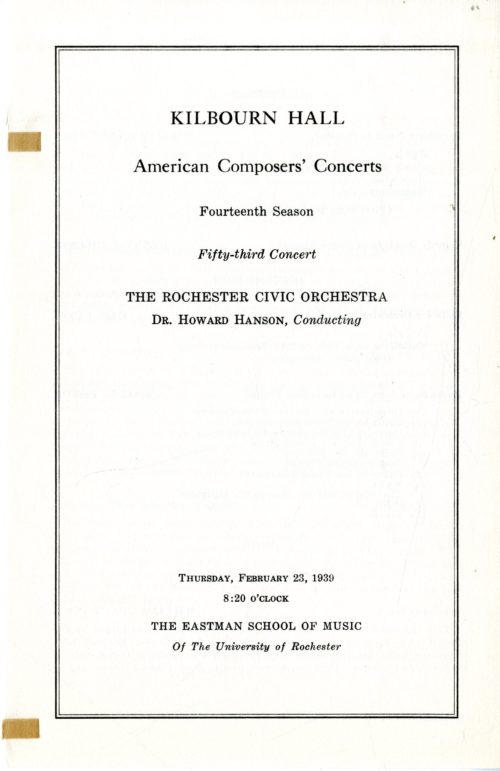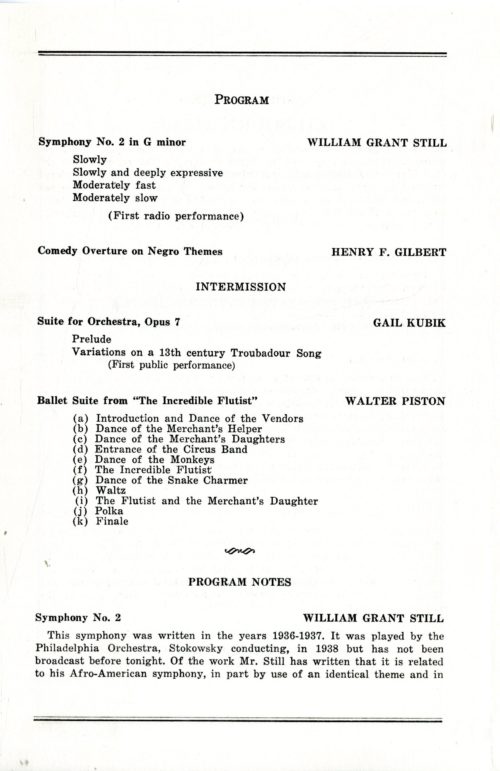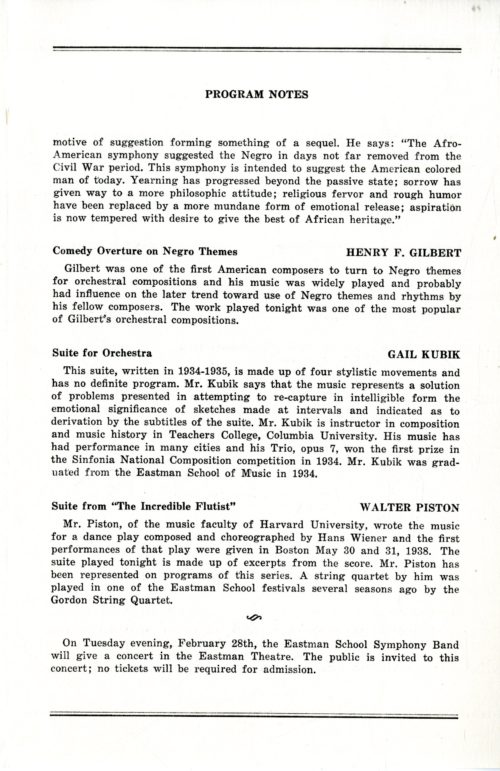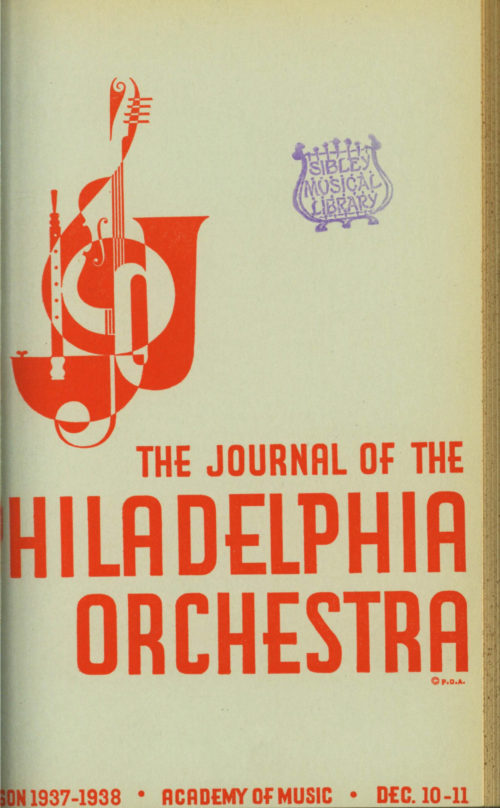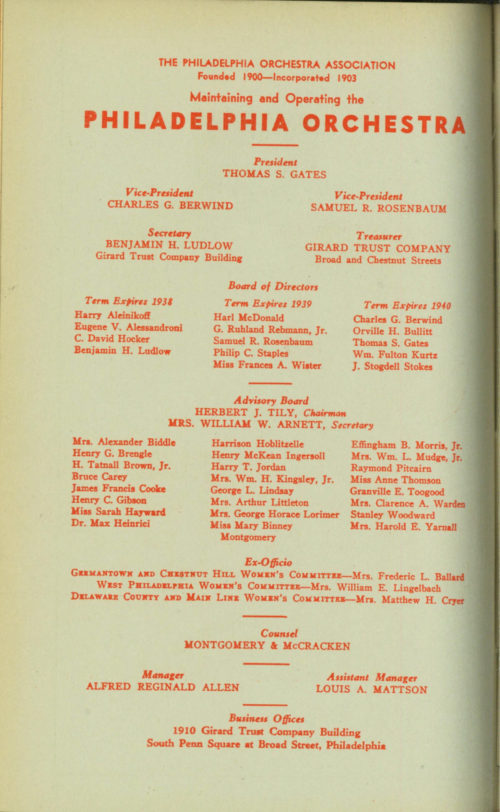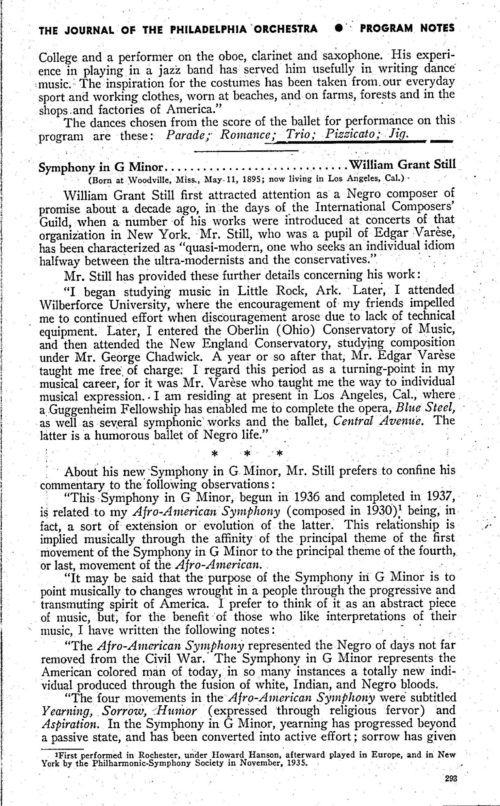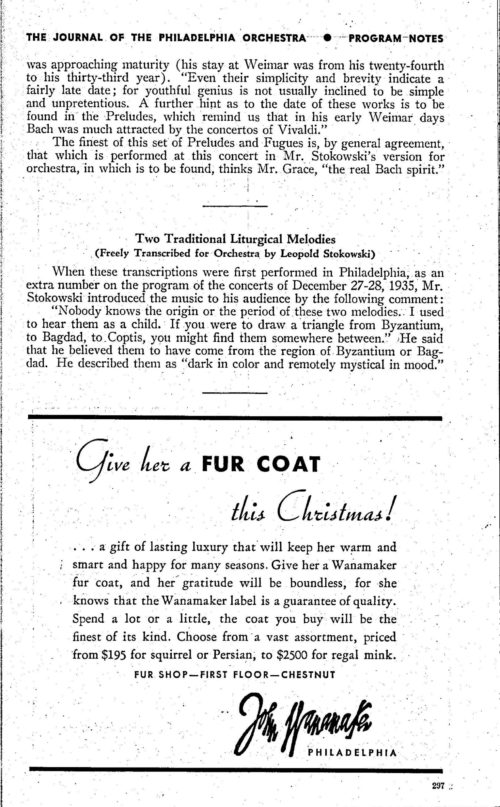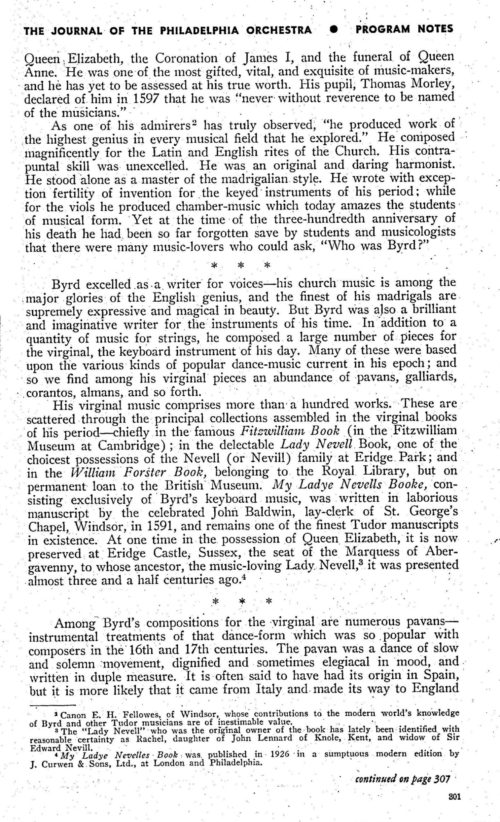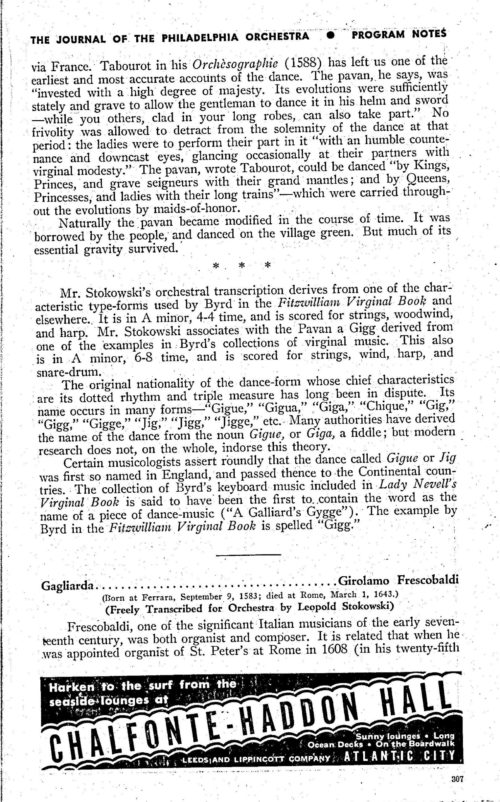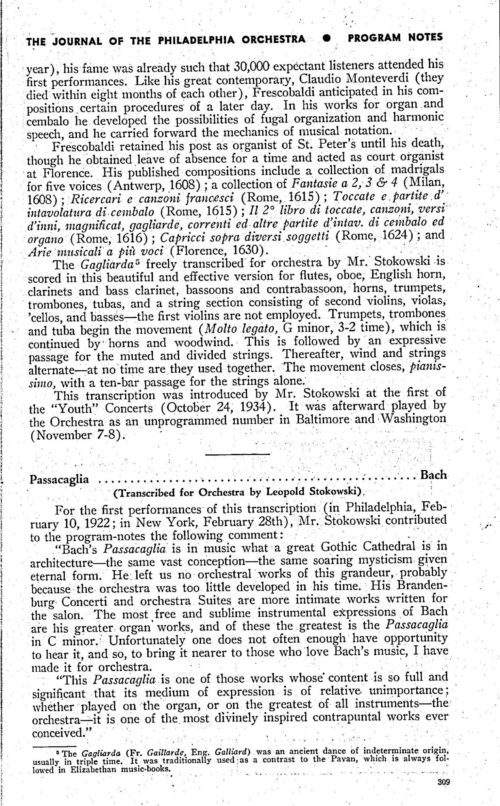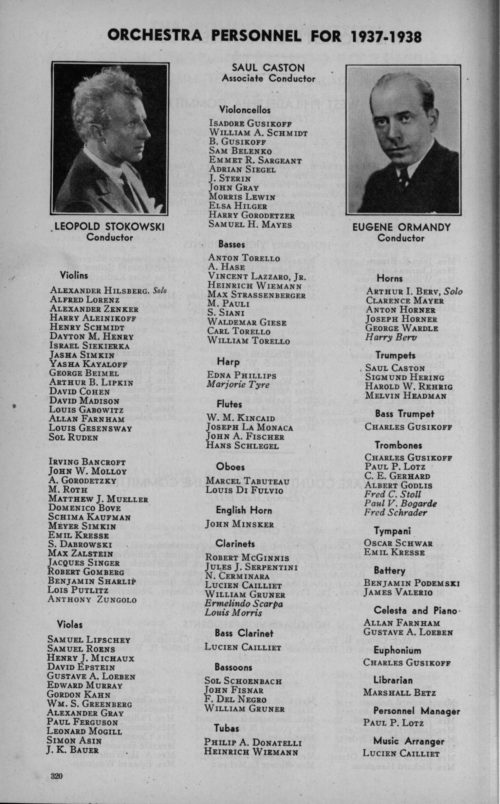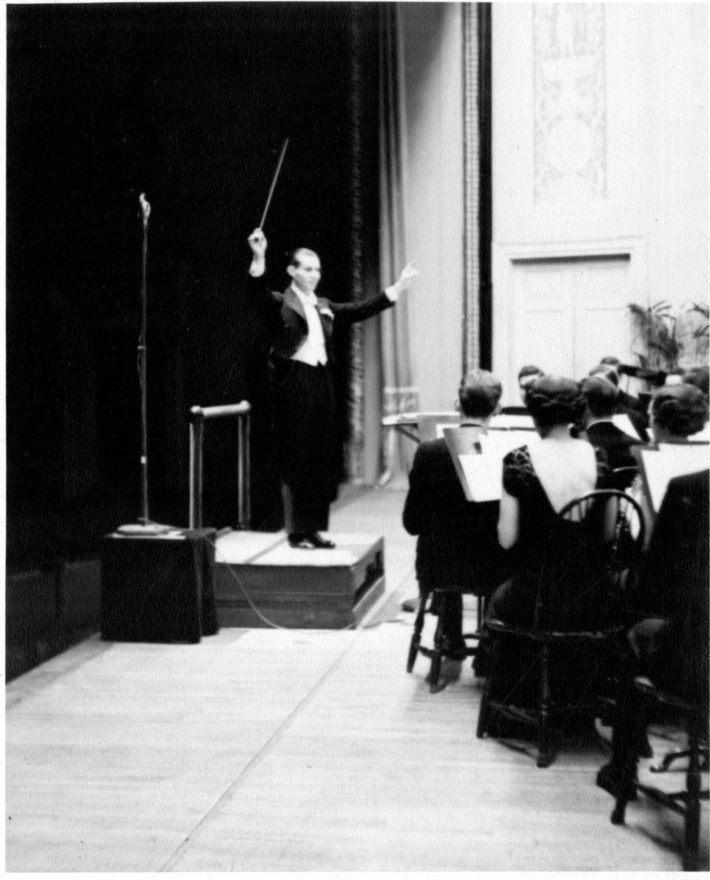Published on Feb 20th, 2023
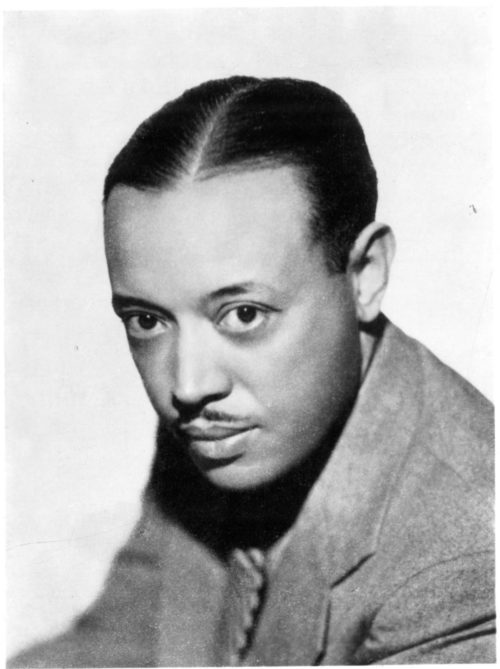
It seems appropriate during Black History Month to take note of a performance given in Kilbourn Hall eighty-four years ago this week, on the evening of February 23rd, 1939, of a new Symphony by William Grant Still (1895-1978), who has frequently been referred to as the dean of African American composers. At an American Composers’ Concert—the Eastman School’s third American Composers’ Concert in the 1938-39 season—Howard Hanson conducted the Rochester Civic Orchestra in a performance of Mr. Still’s Symphony no. 2 in G minor, which had been composed in 1936-37. The performance was significant in that it was promoted (in both the printed concert program and in the Rochester press) as being the first occasion that the Symphony had been broadcast by radio; the concert was broadcast by local station WHAM and was released through WHAM’s facilities to the NBC-Blue Network. Reviews of the concert were printed in the Rochester Evening News, the Rochester Democrat & Chronicle, and the Rochester Times-Union; all were unanimous in describing the manifest interest and rapt attention of the audience, which was a capacity crowd in Kilbourn Hall, such that “standing room was at a premium,” to quote one of the reviewers.
While it wasn’t made explicit on the Eastman School concert program, the Symphony no. 2 in G minor bears the subtitle Song of a New Race. Composed in 1936-37, the Symphony had been premiered by the Philadelphia Orchestra under Leopold Stokowski in that orchestra’s subscription concerts on December 10th and 11th, 1937. (The printed program from those concerts is displayed here, with its substantive program notes by Lawrence Gilman.) The printed program from the Eastman School’s American Composers’ Concert (also displayed here) provides a somewhat shorter program note citing the composer in characterizing the four movements. The performance on February 23rd, 1939 was actually the second performance of the Symphony no. 2 at Eastman that season, for Howard Hanson had conducted it in the Eastman School’s third Annual Symposium of American Orchestral Music[1] the previous October. The Symphony would be performed here again in October, 1940, this time under the composer’s direction, and again in April, 1941, this time performed by the Eastman School Senior Symphony Orchestra under Hanson’s direction. The Symphony clocks in at just under one half-hour in duration. Somewhat surprisingly, no copy of the score is present at the Eastman School, neither in the Ensembles Library nor in the Sibley Music Library. (Howard Hanson’s personal collection does happen to contain scores of several other works by William Grant Still, including his own conducting copy of the ballet Sahdji.)
The Eastman School’s American Composers’ Concerts had been launched by Howard Hanson in 1925 as a vehicle for the performance and promotion of new works by American composers. It was at an American Composers’ Concert on October 29th, 1931 that William Grant Still’s Afro-American Symphony, representing his first symphony, had been premiered. (It was that performance that contributed to the claim, now appearing in more than one printed source, that Mr. Still was the first black American to have a symphony premiered by a leading orchestra. While the orchestra at that 1931 concert was comprised of players drawn from the Rochester Philharmonic Orchestra, the concert was an Eastman School event and not one of the RPO’s subscription concerts.) Mr. Still’s music had first been programmed at Eastman during the 1927-28 season, when Howard Hanson had conducted the tone poem Darker America. Hanson would continue to program Still’s music at the Eastman School’s American Composers’ Concerts and Festivals of American Music in the years ahead. Besides the Afro-American Symphony, those works by Still that had their premiere performances at Eastman included his suites Africa[2] and From the Journal of a Wanderer[3], his ballets La Guiablesse[4] and Miss Sally’s Party[5], and his chamber work Out of the Silence[6]. In addition, his ballet Sahdji was performed at Eastman three times[7] with choreography by Thelma Biracree Schnepel.[8]
► Concert program from February 23rd, 1939, representing the Eastman School’s third American Composers’ Concert of the 1938-39 season. Whereas the American Composers’ Concerts routinely featured premiere performances, this particular concert offered just one, the work by Eastman School alumnus Gail Kubik. Eastman School of Music Archives.
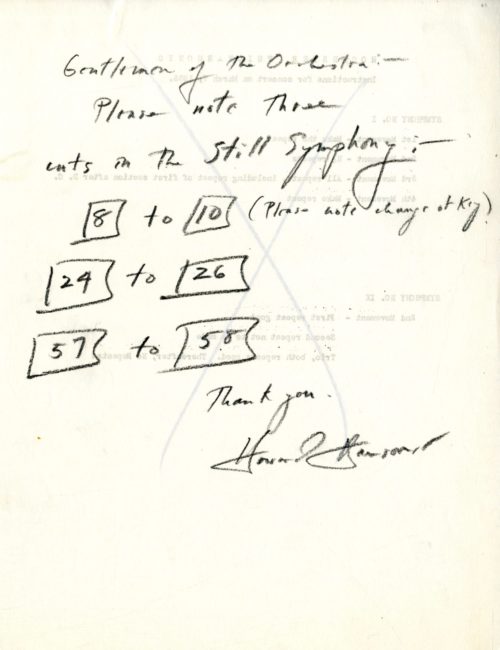
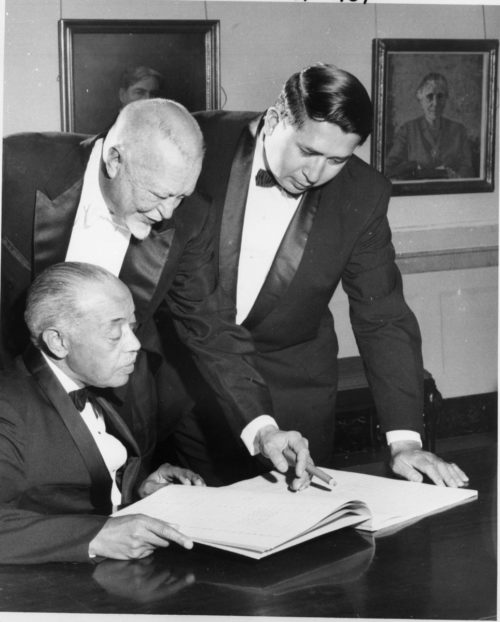
► Printed program from the Philadelphia Orchestra’s subscription concerts of December 10th and 11th, 1937, at which William Grant Still’s Symphony no. 2 in G minor was first introduced. Sibley Music Library.
William Grant Still’s relationship with the Eastman School of Music under Howard Hanson—both in Hanson’s capacity as Director and then as Director of the Institute for American Music following his 1964 retirement—was of considerable importance to his career. The composer publicly acknowledged Hanson’s support on numerous occasions. Dr. Andrea Sherlock Kalyn has described how Hanson, in fact, became Still’s primary advocate and interpreter.[9] Hanson, staunchly valuing the twin crafts of composition and orchestration, recognized the brilliance of Still’s music, and the programming of Still’s works in the American Composers’ Concerts and the Festivals of American Music at Eastman is today reflected in the preservation of master audio discs and tapes in the Eastman Audio Archive.
[1] The Annual Symposium of American Orchestral Music at the Eastman School was another of Howard Hanson’s performance initiatives to promote new works by American composers, specifically those written for the orchestral medium. Held over a four-day period in the fall semester, the Symposium utilized various orchestral forces—the Rochester Civic Orchestra at first, and later the Eastman-Rochester Symphony Orchestra—in presenting the music to the public at no charge. Writing for the Rochester Times-Union in 1938, faculty member Dr. Wayne Barlow (served 1937-78) once described the Symposium as being “in the nature of a research project wherein much new material is examined and given performance, affording an opportunity for the possible discovery of new talent and also providing a ‘proving ground’ for works which will be later repeated at scheduled public concerts in the American Composers’ series.” In that vein, the Still Symphony no. 2 was first presented at Eastman under the auspices of the fall Symposium, and then repeated in an American Composers’ Concert.
[2] At an American Composers’ Concert on October 24th, 1930.
[3] At an American Composers’ Concert on May 8th, 1929.
[4] At the 3rd annual Festival of American Music on May 5th, 1933.
[5] At the 4th annual Festival of American Music on May 2nd, 1941.
[6] At the Annual Symposium of American Orchestral Music on October 28th, 1942. Scored for flute, piano, and string orchestra, the work was performed by the Eastman-Rochester Symphony Orchestra (Hanson conducting) with flutist Joseph Mariano and pianist Irene Gedney.
[7] At three different Festivals of American Music: on May 22nd, 1931; May 4th, 1934; and, May 6th, 1950.
[8] Choreographer and teacher Thelma Biracree Schnepel (1904-1997) is, alas, now only seldom recalled out of Rochester’s cultural past. She operated a ballet school in downtown Rochester in the immediate vicinity of the Eastman School, and was commissioned to choreograph several ballet productions in the Eastman Theater, a number of them produced under the auspices of the Eastman School’s annual Festivals of American Music over roughly a 20-year period. The Sibley Music Library is privileged to own a collection of piano scores used in rehearsals under her direction; finding aid accessible online:
[9] Constructing a Nation’s Music: Howard Hanson’s American Composers’ Concerts and Festivals of American Music, 1925-71 by Andrea Sherlock Kalyn. Thesis (Ph. D.)–University of Rochester, 2001. William Grant Still is discussed in chapter six (pages 280-296).


